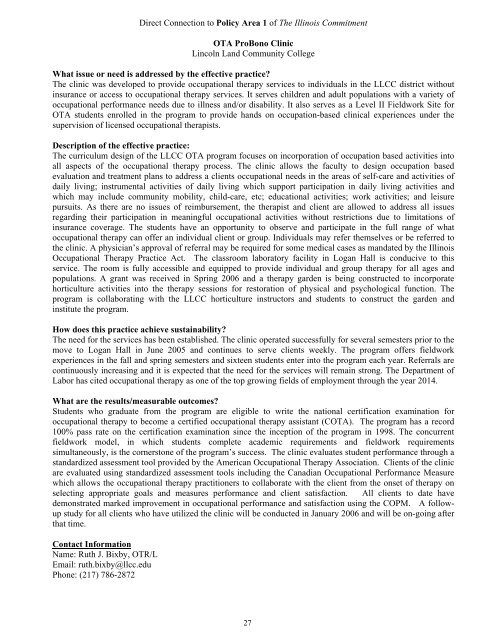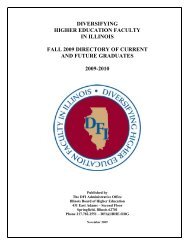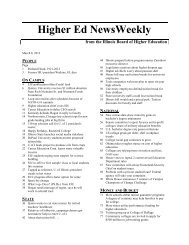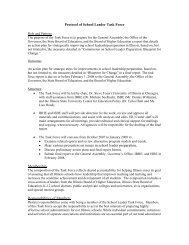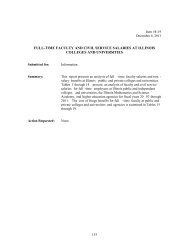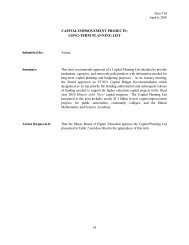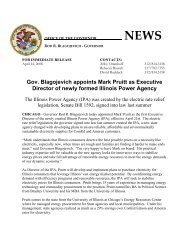Title of Effective Practice: - California Postsecondary Education ...
Title of Effective Practice: - California Postsecondary Education ...
Title of Effective Practice: - California Postsecondary Education ...
Create successful ePaper yourself
Turn your PDF publications into a flip-book with our unique Google optimized e-Paper software.
Direct Connection to Policy Area 1 <strong>of</strong> The Illinois Commitment<br />
OTA ProBono Clinic<br />
Lincoln Land Community College<br />
What issue or need is addressed by the effective practice?<br />
The clinic was developed to provide occupational therapy services to individuals in the LLCC district without<br />
insurance or access to occupational therapy services. It serves children and adult populations with a variety <strong>of</strong><br />
occupational performance needs due to illness and/or disability. It also serves as a Level II Fieldwork Site for<br />
OTA students enrolled in the program to provide hands on occupation-based clinical experiences under the<br />
supervision <strong>of</strong> licensed occupational therapists.<br />
Description <strong>of</strong> the effective practice:<br />
The curriculum design <strong>of</strong> the LLCC OTA program focuses on incorporation <strong>of</strong> occupation based activities into<br />
all aspects <strong>of</strong> the occupational therapy process. The clinic allows the faculty to design occupation based<br />
evaluation and treatment plans to address a clients occupational needs in the areas <strong>of</strong> self-care and activities <strong>of</strong><br />
daily living; instrumental activities <strong>of</strong> daily living which support participation in daily living activities and<br />
which may include community mobility, child-care, etc; educational activities; work activities; and leisure<br />
pursuits. As there are no issues <strong>of</strong> reimbursement, the therapist and client are allowed to address all issues<br />
regarding their participation in meaningful occupational activities without restrictions due to limitations <strong>of</strong><br />
insurance coverage. The students have an opportunity to observe and participate in the full range <strong>of</strong> what<br />
occupational therapy can <strong>of</strong>fer an individual client or group. Individuals may refer themselves or be referred to<br />
the clinic. A physician’s approval <strong>of</strong> referral may be required for some medical cases as mandated by the Illinois<br />
Occupational Therapy <strong>Practice</strong> Act. The classroom laboratory facility in Logan Hall is conducive to this<br />
service. The room is fully accessible and equipped to provide individual and group therapy for all ages and<br />
populations. A grant was received in Spring 2006 and a therapy garden is being constructed to incorporate<br />
horticulture activities into the therapy sessions for restoration <strong>of</strong> physical and psychological function. The<br />
program is collaborating with the LLCC horticulture instructors and students to construct the garden and<br />
institute the program.<br />
How does this practice achieve sustainability?<br />
The need for the services has been established. The clinic operated successfully for several semesters prior to the<br />
move to Logan Hall in June 2005 and continues to serve clients weekly. The program <strong>of</strong>fers fieldwork<br />
experiences in the fall and spring semesters and sixteen students enter into the program each year. Referrals are<br />
continuously increasing and it is expected that the need for the services will remain strong. The Department <strong>of</strong><br />
Labor has cited occupational therapy as one <strong>of</strong> the top growing fields <strong>of</strong> employment through the year 2014.<br />
What are the results/measurable outcomes?<br />
Students who graduate from the program are eligible to write the national certification examination for<br />
occupational therapy to become a certified occupational therapy assistant (COTA). The program has a record<br />
100% pass rate on the certification examination since the inception <strong>of</strong> the program in 1998. The concurrent<br />
fieldwork model, in which students complete academic requirements and fieldwork requirements<br />
simultaneously, is the cornerstone <strong>of</strong> the program’s success. The clinic evaluates student performance through a<br />
standardized assessment tool provided by the American Occupational Therapy Association. Clients <strong>of</strong> the clinic<br />
are evaluated using standardized assessment tools including the Canadian Occupational Performance Measure<br />
which allows the occupational therapy practitioners to collaborate with the client from the onset <strong>of</strong> therapy on<br />
selecting appropriate goals and measures performance and client satisfaction. All clients to date have<br />
demonstrated marked improvement in occupational performance and satisfaction using the COPM. A followup<br />
study for all clients who have utilized the clinic will be conducted in January 2006 and will be on-going after<br />
that time.<br />
Contact Information<br />
Name: Ruth J. Bixby, OTR/L<br />
Email: ruth.bixby@llcc.edu<br />
Phone: (217) 786-2872<br />
27


